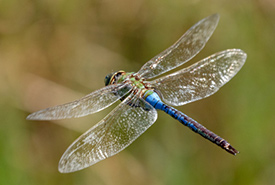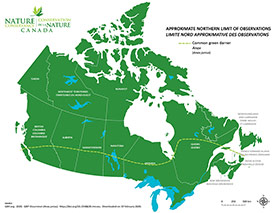
Common green darner (Photo by Nancy Norman, CC BY-NC 4.0)
Common green darner
One of the most widespread and familiar dragonfly species in North America also has a multigenerational long-distance migration that scientists are just starting to unfold. The common green darner has been recorded flying 122 kilometres in a single day, clocking speeds upward of 58 kilometres per hour during migration.
What does it look like?
Common green darner, with its short, thick thorax and long, slender abdomen, is named for its resemblance to a darning needle. This large insect ranges from 6.8 to 8.4 centimetres in length (as big as a hummingbird!) and has a wingspan of nine to 11.4 centimetres.
The green darner has a yellowish-green face, large dark eyes and a dark spot on the top of its head. Males have a dark green thorax and light-blue abdomen, while females and immature dragonflies have a paler green, reddish or brown abdomen. A dark line runs down the upper side of the abdomen in both sexes.
Where does it live?
This dragonfly species ranges throughout North America, from Alaska to southern Canada to the United States. It also occurs in Mexico, Cuba, Cayman Islands, Jamaica, Puerto Rico, Barbados and the Hawaiian Islands.
Common green darner habitats include inland wetlands, ponds, lakes, slow streams, shrublands, forests and grasslands.
Migration nation
Common green darner is one of 16 migratory dragonflies in North America. Like monarchs, these dragonflies embark on a multi-generational migration, where the generation that returns to Canada in spring are the grandchildren of the ones that left in autumn.
In February, the first generation emerges from the southern U.S. (as far south as Mexico and the Caribbean) and migrates north, reaching New England and Canada. There, they mate, lay eggs and eventually die. Their children migrate south from July to October or remain as nymphs over the winter and make the journey south the following year. The third generation born in the south spend their entire lives there, and it is their children that make the long journey back north.
Less than a handful of researchers have studied the mechanics of insect migrations, and fewer on this species. University of Guelph researchers have tracked individual dragonflies, using devices attached to their abdomen, to estimate distances/speeds and visualize the flight paths. Effects of rain and temperatures on migration speed were also investigated.
Others analyzed the hydrogen isotopes, chemical signatures that can roughly be traced along a north-south gradient of the continent, in wing samples. These isotopes allow researchers to determine the general area where the insect was born.
What is this species’ conservation status?
Common green darner is listed as least concern by the International Union for Conservation of Nature.
This species is widespread, and populations are secure across their range. Populations could be impacted where their wetland habitat is lost and if their range shifts with climate change.
What is NCC doing to protect the habitat of this species?
Common green darner has been recorded on many Nature Conservancy of Canada (NCC) properties across Canada. NCC protects wetland habitats such as Ontario’s Wilson Island in Lake Superior. By ensuring there is healthy habitat for insects like green darner, they can hopefully remain a common species for years to come.





